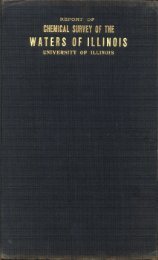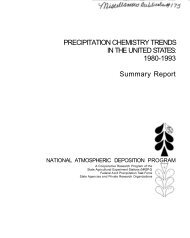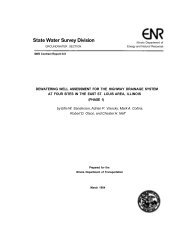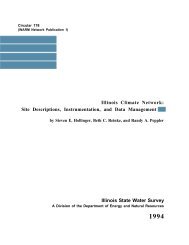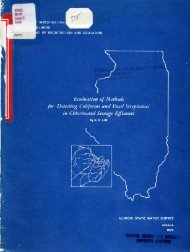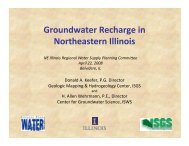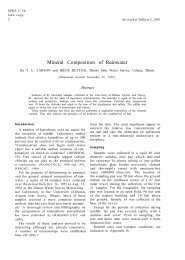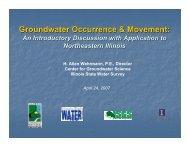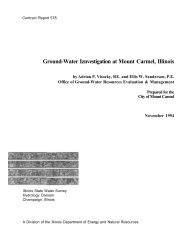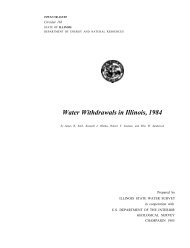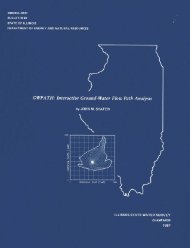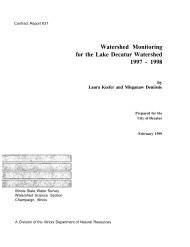Ground-water development in East St. Louis area, Illinois. Urbana, IL ...
Ground-water development in East St. Louis area, Illinois. Urbana, IL ...
Ground-water development in East St. Louis area, Illinois. Urbana, IL ...
Create successful ePaper yourself
Turn your PDF publications into a flip-book with our unique Google optimized e-Paper software.
Generally ground-<strong>water</strong> recharge <strong>in</strong> the <strong>East</strong> <strong>St</strong>.<br />
<strong>Louis</strong> <strong>area</strong> is greatest <strong>in</strong> spr<strong>in</strong>g and early summer<br />
months of heavy ra<strong>in</strong>fall and least <strong>in</strong> the late summer,<br />
fall, and w<strong>in</strong>ter months. Most recharge occurs dur<strong>in</strong>g<br />
spr<strong>in</strong>g months when evapotranspiration is small and<br />
soil moisture is ma<strong>in</strong>ta<strong>in</strong>ed at or above field capacity by<br />
frequent ra<strong>in</strong>s. Dur<strong>in</strong>g summer and fall months evapotranspiration<br />
and soil moisture requirements have first<br />
priority on precipitation and are so great that little precipitation<br />
percolates to the <strong>water</strong> table except dur<strong>in</strong>g<br />
periods of excessive ra<strong>in</strong>fall.<br />
Recharge directly from precipitation was estimated<br />
by flow-net analyses of the piezometric surface <strong>in</strong> the<br />
vic<strong>in</strong>ity of the Wood River, Granite City, National City,<br />
and Monsanto <strong>area</strong> pump<strong>in</strong>g centers. The quantity of<br />
<strong>water</strong> percolat<strong>in</strong>g through a given cross section of an<br />
aquifer is proportional to the hydraulic gradient (slope<br />
of the piezometric surface) and the coefficient of transmissibility,<br />
and it can be computed by us<strong>in</strong>g the follow<strong>in</strong>g<br />
modified form of the Darcy equation (see Ferris,<br />
1959).<br />
where:<br />
Q = T<strong>IL</strong> (10)<br />
Q = discharge through flow cross section, <strong>in</strong> gpd<br />
T = coefficient of transmissibility, <strong>in</strong> gpd/ft<br />
I = hydraulic gradient, <strong>in</strong> ft/mi<br />
L = width of flow cross section, <strong>in</strong> mi<br />
The rate of recharge directly from precipitation can be<br />
estimated on the basis of the difference <strong>in</strong> discharge of<br />
<strong>water</strong> through successive flow cross sections with the<br />
follow<strong>in</strong>g equation (Walton, 1962):<br />
where:<br />
(11)<br />
The + sign is used when there is a <strong>water</strong>-level rise and<br />
the — sign is used when there is a <strong>water</strong>-level decl<strong>in</strong>e.<br />
Flow l<strong>in</strong>es were drawn at right angles to the estimated<br />
piezometric surface contours for December 1956,<br />
June 1961, and June 1962 toward cones of depression<br />
<strong>in</strong> the Wood River, Granite City, National City, and<br />
Monsanto <strong>area</strong>s to delimit the flow channels <strong>in</strong> figures<br />
52 through 54. The locations of flow channels were so<br />
chosen that recharge rates under all types of geologic,<br />
hydrologic, and land use conditions could be studied.<br />
The discharges through cross sections A—A', B—B',<br />
C—C', D—D', E—E', F—F', G—G', and H—H' were<br />
computed us<strong>in</strong>g equation 10 and figures 25 and 52<br />
through 54. Differences <strong>in</strong> discharge of <strong>water</strong> through<br />
successive flow cross sections were determ<strong>in</strong>ed. Average<br />
rates of <strong>water</strong>-level decl<strong>in</strong>es or rises with<strong>in</strong> flow channel<br />
<strong>area</strong>s were estimated from hydrographs of observation<br />
wells. Surface <strong>area</strong>s of flow channels were obta<strong>in</strong>ed<br />
from figures 52 through 54. The average coefficient of<br />
storage of the coarser deposits was estimated to be 0.20<br />
on the basis of aquifer-test data, and the average coefficient<br />
of storage of the f<strong>in</strong>er gra<strong>in</strong>ed alluvium was estimated<br />
to be 0.10 on the basis of studies by Schicht and<br />
Walton (1961). The data mentioned above were substituted<br />
<strong>in</strong> equation 11, and recharge rates for each flow<br />
channel <strong>area</strong> were computed.<br />
Recharge rates vary from 299,000 gpd/sq mi <strong>in</strong> the<br />
National City <strong>area</strong> to 475,000 gpd/sq mi <strong>in</strong> the Wood<br />
River <strong>area</strong>. The average rate of recharge <strong>in</strong> the <strong>East</strong> <strong>St</strong>.<br />
<strong>Louis</strong> <strong>area</strong> is 371,000 gpd/sq mi. The <strong>East</strong> <strong>St</strong>. <strong>Louis</strong> <strong>area</strong><br />
covers about 175 square miles. It is estimated that total<br />
recharge directly from precipitation to the <strong>East</strong> <strong>St</strong>.<br />
<strong>Louis</strong> <strong>area</strong> averages about 65 mgd.<br />
The subsurface flow of <strong>water</strong> from the bluff was<br />
estimated by study<strong>in</strong>g the movement of <strong>water</strong> through<br />
flow channels near the foot of the bluff. Flow l<strong>in</strong>es were<br />
drawn at right angles to the bluff and the estimated<br />
piezometric surface contours for June 1961 and June<br />
1962 to delimit the flow channels shown <strong>in</strong> figures 53 and<br />
54. The discharge through cross sections I—I', J—J',<br />
and K—K' were computed us<strong>in</strong>g equation 10 and figures<br />
25, 53, and 54. Average rates of <strong>water</strong>-level decl<strong>in</strong>es or<br />
rises with<strong>in</strong> flow channel <strong>area</strong>s were estimated from<br />
hydrographs of observation wells. The average rates of<br />
changes <strong>in</strong> storage with<strong>in</strong> flow channel <strong>area</strong>s were computed<br />
as the products of <strong>water</strong>-level changes, storage coefficients,<br />
and flow channel <strong>area</strong>s. Recharge directly from<br />
precipitation with<strong>in</strong> flow channel <strong>area</strong>s was estimated as<br />
the products of the average recharge rate (371,000<br />
gpd/sq mi) and flow channel <strong>area</strong>s. Recharge and<br />
changes <strong>in</strong> storage with<strong>in</strong> flow channel <strong>area</strong>s were subtracted<br />
from the discharges through cross sections I—I',<br />
J—J', and K—K' to compute rates of subsurface flow of<br />
<strong>water</strong> from the bluff. The average rate of subsurface flow<br />
of <strong>water</strong> from the bluff is 329,000 gpd/mi. The length of<br />
the bluff form<strong>in</strong>g the eastern boundary of the <strong>East</strong> <strong>St</strong>.<br />
<strong>Louis</strong> <strong>area</strong> is 39 miles. Thus, the total rate of subsurface<br />
flow of <strong>water</strong> from the bluffs is about 12.8 mgd.<br />
46



